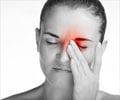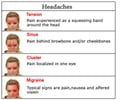Temporomandibular disorder, or TMD may increase the frequency and severity of migraine attacks, even though it does not directly cause migraine.

‘One of the most common symptoms described by Temporomandibular Joint Disorder patients is the regular occurrence of headaches, many of which are extremely severe. TMD headaches are commonly diagnosed as Migraine.’





"Our study shows that patients with chronic migraine, meaning attacks occurring on more than 15 days per month, are three times as likely to report more severe symptoms of TMD than patients with episodic migraine," said Lidiane Florencio, the first author of the study, which is part of the Thematic Project "Association study of clinical, functional and neuroimaging in women with migraine", supported by the São Paulo Research Foundation - FAPESP. Previous studies already indicated that migraine is somehow associated with pain in the chewing muscles. However, this research was the first to consider the frequency of migraine attacks when analyzing its connection with TMD: eighty-four women in their early to mid-thirties were assessed, being that 21 were chronic migraine patients, 32 had episodic migraine, while 32 with no history of migraine were included as controls - the results were published in the Journal of Manipulative and Physiological Therapeutics.
Signs and symptoms of TMD were observed in 54% of the control participants without migraine, 80% of participants with episodic migraine, and 100% of those with chronic migraine.
For Florencio, central sensitization may explain the association between the frequency of migraine attacks and the severity of TMD.
"The repetition of migraine attacks may increase sensitivity to pain," she said. "Our hypothesis is that migraine acts as a factor that predisposes patients to TMD. On the other hand, TMD can be considered a potential perpetuating factor for migraine because it acts as a constant nociceptive input that contributes to maintaining central sensitization and abnormal pain processes." Nociceptive pain is caused by a painful stimulus on special nerve endings called nociceptors.
Advertisement
Which came first?
Advertisement
"Migraine patients are more likely to have signs and symptoms of TMD, but the reverse is not true. There are cases of patients with severe TMD who don’t present with migraine," said Débora Grossi, the lead researcher for the study and principal investigator for the Thematic Project. The researchers believe that TMD may increase the frequency and severity of migraine attacks, even though it does not directly cause migraine.
"We do know migraine isn’t caused by TMD," Florencio said. "Migraine is a neurological disease with multifactorial causes, whereas TMD, like cervicalgia - neck pain - and other musculoskeletal disorders, is a series of factors that intensify the sensitivity of migraine sufferers. Having TMD may worsen one’s migraine attacks in terms of both severity and frequency."
The journal article concludes that an examination of TMD signs and symptoms should be clinically conducted in patients with migraine.
"Our findings show the association with TMD exists but is less frequent in patients with rare or episodic migraine," Grossi said. "This information alone should change the way clinicians examine patients with migraine. If migraine sufferers tend to have more severe TMD, then health professionals should assess such patients specifically in terms of possible signs and symptoms of TMD."
Source-Eurekalert















